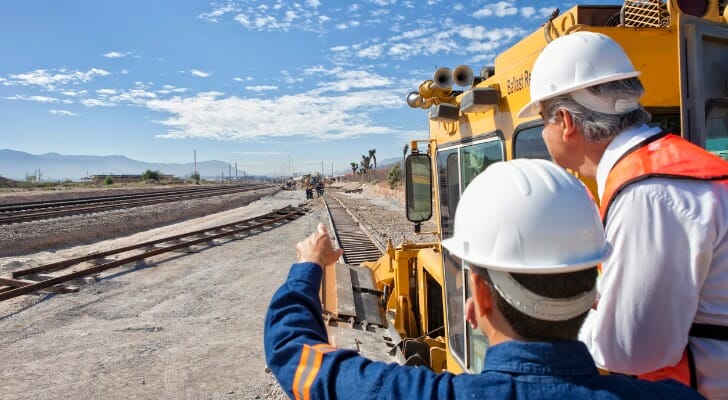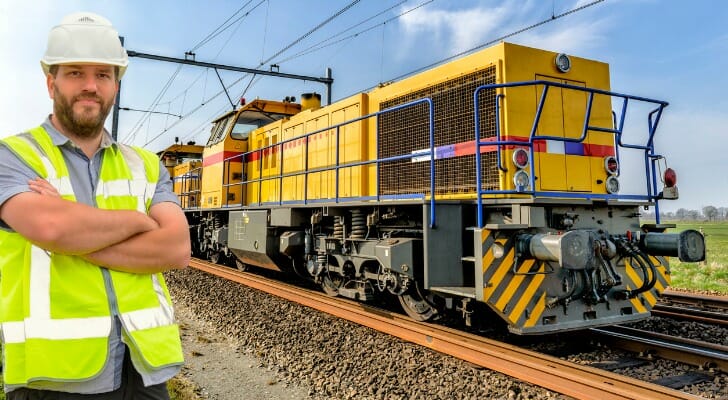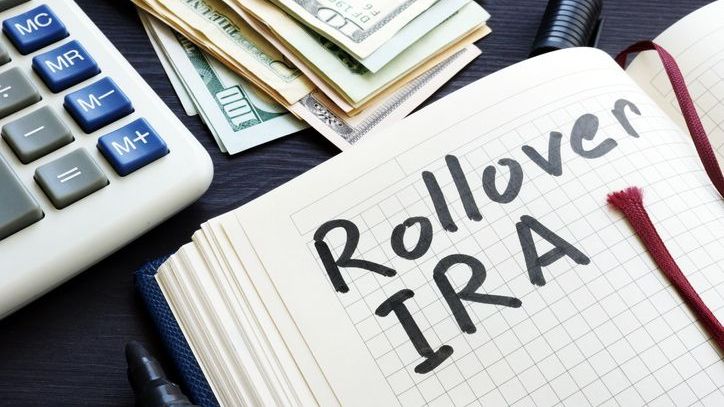

The Railroad Retirement Program is a federal program that extends retirement benefits to railroad employees. The program was established in the 1930s and in addition to retirement benefits, it also pays survivor, unemployment and sickness benefits to eligible railroad workers and their families. The Railroad Retirement Board (RRB), an independent federal agency based in Chicago, is responsible for overseeing the program. If you’re a railroad employee, here’s more on how the program works and where it can fit into your retirement plans.
Consider working with a financial advisor as you develop a retirement plan or modify an existing one.
The Railroad Retirement Program is similar to Social Security, in terms of the benefits it offers. But there are several key differences between the two.
First, railroad workers only pay money into the Railroad Retirement plan, not Social Security. The money railroad workers pay in taxes goes into funding the Railroad Retirement Program and the benefits it pays. You can’t double-dip and receive full benefits from both railroad retirement and Social Security.
Benefits are paid out to workers based on the number of months of service they have as railroad employees and their earnings credits. Employees receive one month of credit for every month they work for an eligible railroad employer, regardless of how many days of the month they actually worked.
The RRB is responsible for administering retirement benefit payments. These benefits can’t be paid until you end your railroad employment. You also have to reach a certain age threshold to apply for railroad retirement benefits.
The earliest age that you could draw railroad retirement benefits is 60, if you have 30 years of qualifying railroad service. You can receive your full railroad retirement benefit at this age if you meet the 30 years of service retirement. Otherwise, you can start drawing railroad retirement benefits at age 62. But just like Social Security, your benefit amount is reduced for each year before full retirement age that you start drawing benefits.
Spouses can also receive retirement benefits once they reach a certain age. The benefit amount they’re able to draw depends on how old their spouse is, the number of years of service they have as a railroad employee and when they retire. But generally, if you retire at age 60 with 30 years of railroad service your spouse would be able to begin receiving benefits once they turn 60 if they haven’t already. The same rules apply for reducing benefit amounts when retirement benefits are taken before your spouse reaches their full retirement age.

Benefits from the Railroad Retirement Program are broken up into two tiers. Each one got a boost in 2023. Also, the average regular railroad retirement employee annuity increased $215 a month to $3,344, and the average of combined benefits for an employee and spouse increased $304 a month to $4,838. For eligible widows and widowers, the average annuity increased $120 a month to $1,691.
The first tier includes retirement, survivor and disability benefits. In 2023 Tier I benefits increased 8.7%, which is the percentage of the consumer price index (CPI) increase. This is the largest increase since 1981, when it rose 11.2%.
Tier 1 benefits are available to railroad workers who have at least 10 years of service for an employer covered under the Railroad Retirement Act. The years of service requirement is shortened to five years for employees who got started working for the railroad after 1995. Again, you can receive your full railroad retirement benefit starting at age 60 if you have 30 years of qualifying service. Normal full retirement age for railroad benefits is 65 or 67, depending on the year you were born.
Tier 1 also provides a smaller annuity payment to eligible railroad employees who have at least 25 years of service, began working for the railroad prior to Oct. 1, 1981, and are still working for the railroad. The minimum age to receive this added benefit is 60 for workers with at least 30 years of service.
Aside from retirement benefits, Tier 1 also pays out:
The amount paid out for these benefits is tied to the railroad employees years of service and their age can also come into play for spousal benefits.
Tier II benefits, which are additional to Tier I benefits, rose in 2023 by 2.8%, which is 32.5% of the CPI increase.
They pay out similarly to a private pension, which is based on the employee’s average income for their five highest-earning years. The length of service an employee has also influences the minimum pension payment they’ll receive through the Tier II benefits. Current spouses and surviving widows can also receive this benefit.
While you could technically still work and receive railroad retirement benefits the way you could with Social Security, there is one catch. You can’t be employed by any organization covered under the Railroad Retirement Act. In other words, if you want to receive railroad retirement benefits and still work you’d have to choose something outside the railroad industry.
Another change for 2023 is an increase in the amount beneficiaries can earn outside of their railroad work and not have those earnings result in reduced railroad retirement benefits.
The exempt earnings amount for those under full retirement age throughout 2023 rises to $21,240 from $19,560 in 2022. For who reach full retirement age in 2023, the exempt earnings amount, for the months before the month they reach full retirement, increases to $56,520 in 2023 from $51,960 in 2022, according to the RRB. For people who have not reached full retirement age in 2023, the earnings deduction is $1 in benefits for every $2 of earnings over the exempt amount. For people who have reached full retirement age in 2023, the deduction is $1 for every $3 of earnings over the exempt amount in the months before the month they reach full retirement age.
When applicable, these earnings deductions are assessed on the Tier I portion of railroad retirement employee and spouse annuities, and the Tier I and Tier II portions of survivor benefits.
Interest, dividends, certain rental income and income from securities are not considered earnings for this purpose. However, earnings from services rendered, plus earnings from self-employment are considered earnings when calculating a person’s earnings limits.
Railroad retirement benefits don’t start automatically; you have to apply for them just like Social Security. You can do that by contacting your closest RRB office.
From there, you’ll have to complete the application for benefits. You can do so up to three months before your actual retirement date. Applications can be submitted over the phone, by mail or in person.
When applying for railroad retirement benefits you’ll have to provide:
Remember, you have to sever your employment with the railroad before you can apply for benefits. If your application is in order, it can take 30 to 60 days to start receiving benefits.

The Railroad Retirement Program can offer generous financial benefits to railroad workers and their families. Specifically, it pays survivor, unemployment and sickness benefits to eligible railroad workers and members of their families. If you work for the railroad, it’s important to consider how these retirement benefits can help with shaping your long-term financial plan. While similar to Social Security, it is important to understand how Railroad Retirement Program benefits differ from those of Social Security.
Photo credit: ©iStock.com/MiguelMalo, ©iStock.com/teppakorn tongboonto, ©iStock.com/Sjo
Rebecca Lake, CEPF®Rebecca Lake is a retirement, investing and estate planning expert who has been writing about personal finance for a decade. Her expertise in the finance niche also extends to home buying, credit cards, banking and small business. She's worked directly with several major financial and insurance brands, including Citibank, Discover and AIG and her writing has appeared online at U.S. News and World Report, CreditCards.com and Investopedia. Rebecca is a graduate of the University of South Carolina and she also attended Charleston Southern University as a graduate student. Originally from central Virginia, she now lives on the North Carolina coast along with her two children. Rebecca also holds the Certified Educator in Personal Finance (CEPF®) designation.
Read More About Retirement



More from SmartAsset
SmartAsset Advisors, LLC ("SmartAsset"), a wholly owned subsidiary of Financial Insight Technology, is registered with the U.S. Securities and Exchange Commission as an investment adviser. SmartAsset's services are limited to referring users to third party advisers registered or chartered as fiduciaries ("Adviser(s)") with a regulatory body in the United States that have elected to participate in our matching platform based on information gathered from users through our online questionnaire. SmartAsset receives compensation from Advisers for our services. SmartAsset does not review the ongoing performance of any Adviser, participate in the management of any user's account by an Adviser or provide advice regarding specific investments.
We do not manage client funds or hold custody of assets, we help users connect with relevant financial advisors.
This is not an offer to buy or sell any security or interest. All investing involves risk, including loss of principal. Working with an adviser may come with potential downsides such as payment of fees (which will reduce returns). There are no guarantees that working with an adviser will yield positive returns. The existence of a fiduciary duty does not prevent the rise of potential conflicts of interest.